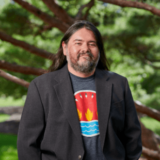
It’s Time to End Public Law 280
Contributors
-
 Eugene Sommers, White Earth Nation
Eugene Sommers, White Earth Nation -
 Matthew Fletcher, Grand Traverse Band of Ottawa and Chippewa Indians
Matthew Fletcher, Grand Traverse Band of Ottawa and Chippewa Indians -
 Tadd Johnson, Bois Forte Band of Chippewa
Tadd Johnson, Bois Forte Band of Chippewa
Early one morning during the summer of 2020, Eugene Sommers and his cousin ventured out to check the fishing net they’d set up the night before. (Placing nets overnight allows netters to catch multiple fish at once; netting is an important Ojibwe cultural practice.) They’d traveled just under a mile from Eugene’s home on the White Earth Indian Reservation in northern Minnesota when they saw flashing lights in their rearview mirror.
A police officer appeared at the car window and informed the duo that their license plate light was out. Expecting a brief interaction, Eugene was taken aback when the officer told him to step out of the car for a search of the vehicle. He immediately thought of his net and the rotting fish that might be waiting for him if he delayed any longer.
Eugene asked the officer to explain his rationale for the search; the officer claimed he smelled marijuana. A citizen of White Earth Nation, Eugene told the officer that he wanted to speak with a Tribal police officer first and didn’t consent to the search. The officer rebuffed his request.
“He told me to stop being a smart ass and pulled me out of my vehicle,” Eugene explains. “He cuffed me and threw me in the back of his vehicle. And then he took my cousin out. He was a minor at the time. He threw my nets down. He messed up my eagle feather. He cracked my shell–my smudge bowl. He went through my pipe bag. I found my pipe in two pieces. I usually have it wrapped up in my pipe bag. But I found the head of the pipe under my seat.”
The officer concluded his search, finding no marijuana in Eugene’s vehicle. Eventually, Tribal police officers arrived and let Eugene out of the back of the squad car. Eugene didn’t receive a ticket, and he and his cousin were finally free to leave. But the encounter left both of them shaken and disappointed. Eugene’s sacred items were damaged and disrespected. His request to speak with an officer employed by his nation was ignored.
Public Law 280’s Termination-Era Beginnings
Why was Eugene stopped and searched by a non-Tribal police officer while traveling through his own sovereign nation? A little-known law called Public Law 280 is largely responsible. To understand how we got here and Public Law 280’s modern-day implications for Tribal sovereignty and public safety, we have to look back to the Termination Era, one of the many dark chapters in federal Indian policy.
The 1950s Termination Era was, to put it succinctly, an attempt at erasure. The United States government decided that the best way to deal with the “Indian problem” was to eliminate Native nations and assimilate Native people into white America. As part of a suite of harmful Termination-era legislation, the federal government passed Public Law 280 in 1953. The legislation initially included five states–Minnesota, Wisconsin, Nebraska, Oregon, and California. When Alaska received statehood in 1959, it opted into Public Law 280. Other states later adopted elements of the legislation, too. Today, Public Law 280 remains on the books for these six states, plus a handful of states who adopted parts of the legislation.
Unsurprisingly, the federal government failed to consult with or receive consent from Native nations before passing Public Law 280. Why did the United States government select these particular states to fall under the law? University of Minnesota law professor and Senior Director of American Indian Tribal Nations Relations Tadd Johnson explains, “The reason is, in those states, there’s a patchwork quilt of land ownership. There are a lot of non-Indians living inside reservation boundaries.” During the Allotment and Assimilation Era (another dark chapter in federal Indian policy that preceded Termination), a massive theft of Native land took place. Many non-Native people acquired land within Native nations. In fact, as Tadd Johnson notes, non-Natives stole, with the aid of governmental programs, ⅔ of allotted Native lands in Minnesota during this period.
Public Law 280 attempted to soothe unfounded white fears about “lawlessness” on reservations; it aimed to make living on stolen land even more comfortable for white colonizers by reducing Native control over criminal justice. The Native nations who lost the most land during Allotment received yet another blow via Public Law 280: they faced additional limits on their ability to make key public safety decisions for their people. This law is a shameful relic of the United States’ Termination policy. Tadd Johnson notes, “It’s still on the books, yet it’s part of an era that Richard Nixon declared to be over in 1970.”
Public Law 280 Basics
Native nations are inherently sovereign; they operate as nations within a nation. (Learn more about what sovereignty means and how it works in this video.) Other sovereign entities, France for example, have full control over their law enforcement, courts, and public safety systems. The United States has denied Native nations that authority. “Tribes are one of the few places in the world that don’t have territorial jurisdiction over people who walk onto their lands,” Tadd Johnson explains. “Which is very odd. Because if you go to France, you expect to get arrested by French authorities if you commit a crime there. If you go to Wisconsin, you expect the same thing.”
SOVEREIGNTY
The natural right of a people to govern themselves.
Before the passage of Public Law 280, Native nations shared criminal jurisdiction with the federal government. State governments rarely intervened in crimes taking place on Native lands; state and county police did not make regular appearances on reservations. The state, essentially, only dealt with cases in which both parties were non-Native. Native nations handled misdemeanors committed by Native people, and the federal government handled major crimes involving Native and non-Native actors. What changed after the passage of Public Law 280? In a nutshell, the law granted non-Tribal law enforcement entities greater control over Native people and lands.
With that change, state criminal laws applied to reservations. States now had jurisdiction over crimes committed by or against Native people in Indian Country. This meant that they gained the ability to handle minor crimes (something previously exclusive to Native nations) and took over the responsibility for major crimes from the federal government. Under Public Law 280, states and Native nations have something called concurrent jurisdiction. This means that Native nations’ previous jurisdiction is not altered, but they must now share jurisdiction with the state.
Policing Under Public Law 280: Unsafe and Unjust
Native nations in those states without Public Law 280 have a much greater degree of agency over their policing systems; they can choose between several models. For example, nations can ask the Bureau of Indian Affairs (BIA) to administer their police department using federal employees and funding. Or, they can choose to fund, design, and staff their department entirely on their own terms. Most non-Public Law 280 nations use a “638ed” department model. A “638ed” department means that nations administer their police department under contract with the BIA: the BIA sets the organizational framework and provides basic funding, and the nation staffs the department with Tribal employees.
For Public Law 280 nations, the default scenario involves county and state police administering public safety on reservations. Is there any way for Native nations in Public Law 280 states to hire and retain their own police officers? The state of Minnesota, for example, approved a statute in 1998 allowing for Public Law 280-eligible nations to hire their own Peace Officer Standards and Training (POST)-certified officers, provided that they receive approval from surrounding counties. Essentially, a Native nation must enter into an agreement with a county in order to gain permission to hire and use its own officers. This sounds like a great potential solution to the problems caused by Public Law 280, but it’s problematic for several reasons.
Counties Hold the Power
Even if a Native nation manages to secure an agreement that allows them to hire their own officers, these officers are not categorically different from county officers. Law professor Matthew Fletcher explains: “The fact that the Tribal police are Minnesota POST-certified means that they are in a lot of ways not any different than the county police. Yes, there may be Indian or Tribal preference in hiring, so you’re more likely to have Native people as cops, but they’re still the same cops, for all practical purposes. They have lethal weapons on them. They’re trained to do exactly the same things as the county police.”
If a Public Law 280-eligible Native nation ever decided that they’d prefer to only have Tribal police officers patrolling their lands, it’s highly unlikely that they’d be able to make this happen. “My sense is, you could certainly try to negotiate for that, but you’re probably not going to get it,” Matthew Fletcher notes. “The county will say, well, that’s not acceptable because you have non-Indians on the reservation. We’re going to have a mix, at best. We’re coming on the reservation whether you like it or not.”
The requirement that nations enter into an agreement with surrounding counties means that the counties hold the power. If the relationship between a Native nation and a county becomes strained, that county can arbitrarily decide to terminate the policing agreement. This can result in the nations’ trained police officers being forced to sit idle (they’re not approved to serve unless the agreement is in place) while emergencies go unanswered and crimes go uninvestigated. Oftentimes, nations must give up a lot of agency to a county in order to even sign an agreement in the first place. For example, counties can request that they determine which officers from a Tribal police department receive certification, effectively stripping control away from the Native nation.
“We had 32 Tribal cops sitting on their hands for two years. If they tried to respond, [our cops] were threatened with arrest by the County, after they had worked hand in hand with the County for years. During that time, we lost about 100 people.”
-Tadd Johnson
Lives Lost
To demonstrate the effects of these complexities on individuals, we’ll use the Mille Lacs Band of Ojibwe as an example. The Mille Lacs Indian Reservation (located in North Central Minnesota) shares geography with Mille Lacs County. In order for the Mille Lacs Band of Ojibwe to hire their own police officers, they must secure an agreement with the County. Mille Lacs County and the Mille Lacs Band of Ojibwe have been involved in an ongoing dispute over the borders of the Mille Lacs Reservation. The Treaty of 1855 guarantees the Mille Lacs Band a 61,000-acre reservation. Meanwhile, Mille Lacs County insists that the Reservation is only about 4,000 acres.
In 2016, after nearly 25 years of cooperating on public safety, Mille Lacs County terminated its agreement with the Mille Lacs Band. Tadd Johnson explains, “[The Reservation] became kind of a cop-free zone. We had 32 Tribal cops sitting on their hands for two years. If they tried to respond, [our cops] were threatened with arrest by the County, after they had worked hand in hand with the County for years. During that time, we lost about 100 people. About 20 people died from crime-related matters. And we had about 100 overdoses. We had someone freeze to death because they were high on drugs, and there were no police around. It was a really awful time.”
Eventually, in 2018, the Mille Lacs Band of Ojibwe and Mille Lacs County reinstated the policing agreement. But the damage was already done. Lives were unnecessarily, tragically, lost. As long as PL 280 remains in place at the state level, and County leadership refuses to acknowledge the Mille Lacs Band’s sovereignty, public safety will be at risk. The chances of Mille Lacs Band of Ojibwe citizens ever having enough voting power to make significant change in the majority-white Mille Lacs County are slim to none.
Public Law 280: Confusing and Unfunded
Public Law 280 is not only dangerous, it also causes funding issues and jurisdictional confusion for all involved parties. First, Public Law 280 does not mandate that the federal government provide financial support to participating states, despite the fact that under the law, they are required to take on expanded law enforcement duties. Matthew Fletcher explains, “It’s all state tax dollars that are required, obligated by federal law, to handle Indian Country criminal jurisdiction, which is a federal responsibility at heart. And that costs lots of money.” In addition to putting pressure on state budgets and capacity, Public Law 280 has drastically reduced federal financial support for Native nations in participating states, especially for nations’ law enforcement and justice systems.
According to a report assembled by the state of California court system, Public Law 280 has resulted in confusion over authority (who can enforce what) and overlapping jurisdiction, ultimately causing Native nations to see inconsistent response times to crimes taking place on their lands. In missing person cases, for example, families often struggle to determine who has primary jurisdiction. Matthew Fletcher sheds light on how uncertainty caused by concurrent jurisdiction can play out: “It’s likely that there is often a race to the court, or a race to the incident, and whoever gets there has jurisdiction. If the Tribe and the county are not playing well with each other, and there are a lot of conflicts between them, then you’ll have these jurisdictional conflicts as well. And, I wouldn’t say that it rises to the level of a standoff between police, but it can get pretty hostile at times.” Public Law 280 creates an unnecessary jurisdictional maze that harms both Native and non-Native people living on Native lands.
What Does the Future Hold?
Leading Public Law 280 scholar Carole Goldberg notes that when Native nations enforce their own laws, public safety improves. Native control over law enforcement and courts ultimately saves state and local governments money, too. So, why haven’t we abolished Public Law 280 for good? The answer is, it’s complicated. First, we can’t forget about the role that systemic racism plays in the conversation. Many non-Native governments, and non-Native people, continue to limit Native nations’ ability to fully exercise their sovereignty. Sovereignty makes them uncomfortable, and ending Public Law 280 would be seen as a victory for Tribal sovereignty.
The method for withdrawing from Public Law 280 that’s currently available to Native nations, called retrocession, requires them to reach consensus with local and state governments. Once approved, retrocession allows a Native nation to return to the old system (sharing criminal jurisdiction with the federal government alone). Unfortunately, retrocession is often impossible, despite a nation’s wishes. In order to retrocede, a Native nation must reach agreement with overlapping counties. Then, the state sharing geography with the nation must submit the retrocession request to the Secretary of the Interior for approval. Bills allowing for Native nations to initiate their own retrocession efforts have failed in Congress and many states.
The federal government has made a few attempts to reduce the negative impacts of Public Law 280, but problems continue to persist. For example, in 2010, the Tribal Law and Order Act (TLOA) was signed into law. The TLOA allows Native nations in Public Law 280 states to request support from the federal government. (The state’s jurisdiction over that nation does not change as a result.) In 2015, the Senate Committee on Indian Affairs held a roundtable discussion with Tribal leaders on the TLOA’s progress. Leaders shared concerns about lack of funding, response times, and jurisdictional complexity–many of the same issues they faced before the passage of the TLOA.
Fast forward to May 2020. We witnessed the beginning of a global uprising around issues related to police brutality and systemic racism. Since then, communities have increasingly started to examine, analyze, and reimagine their policing and public safety systems. They’re asking questions such as, “Do all of us feel safe in our neighborhoods? Are we disproportionately harming groups of people in the name of safety? What does safety mean to us? Who should be in charge of keeping us safe?”
Native people deserve the chance to ask and answer these same questions for their nations. They deserve the ability to make changes if they determine that their public safety systems aren’t working. But Public Law 280 severely limits Native nations’ agency over their own safety. Native people are killed by police at a higher rate (2.9 annual average deaths per one million population) than any other racial or ethnic group in the United States, yet they face unique, little-known barriers to reimagining their own public safety.
Public Law 280 is unsafe, unjust, inefficient, and confusing. The quick fixes offered by our government have failed to make a difference. The way out–retrocession–is untenable for most Native nations. Now, more than ever, we need a movement to put an end to Public Law 280.